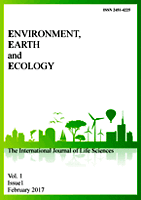| 1. |
Behra R, Krug H (2008) Nanoecotoxicology-Nanoparticles at large. Nature Nanotechnology, 3: 253-254. doi: 10.1038/nnano.2008.113.
|
| 2. |
Brunner TI, Wick P, Manser P, Spohn P, Grass R N, Limbach L K, Bruinink A, Stark WJ (2006) In vitro cytotoxicity of oxide nanoparticles: comparison to asbestos, silica, and effect of particle solubility. Environmental Science & Technology. 40, 4374-4381.
|
| 3. |
Crabtree RH (1998): A new type of hydrogen bond. Science 282:2000–2001.
|
| 4. |
Dahindwal AS, Lather BPS, Singh J (1991) Efficacy of seed treatment on germination, seedling emergence and vigor of cotton (Gossypium hirsutum) genotypes. Seed Research, 19: 59-61.
|
| 5. |
Feizi H, Rezvani Moghaddam P, Shahtahmassebi N, Fotovat A (2012) Impact of bulk and nanosized titanium dioxide (TiO2) on wheat seed germination and seedling growth. Biological Trace Element Research, 146: 101-106.
|
| 6. |
Gaballah M S, Mandour MS (2000) Increasing drought resistance of wheat plants during grain filling by using chemical desiccants. Journal of Science, Mansoura Univ., 25(2): 833-841.
|
| 7. |
Gogos A, Knauer K, Bucheli TD (2012) Nanomaterials in plant protection and fertilization: Current state, foreseen applications, and research priorities. Journal of Agriculture and Food Chemistry, 60(39): 9781-9792.
|
| 8. |
Hghighi M, Heidarian S, Teixeira Silva JA (2012) The effect of titanium amendment in N- withholding nutrient solution on physiological and photosynthesis attributes and micronutrient uptake of tomato. Biological Trace Element Research, 150: 381-90. doi: 10.1007/s12011-012-9481-y.
|
| 9. |
Hong FH, Yang F, Liu C, Gao Q, Wan ZG, Gu FG, Wu C, Ma ZN, Zhou J, Yang P (2005) Influences of nano-TiO2 on the chloroplast aging of spinach under light. Biological Trace Element Research, 104: 249-260. PMID: 15930594.
|
| 10. |
Lei Z, Mingyu S, Chao L, Liang C, Hao H, Xiao W, Xiaoqing L, Fan Y, Fengqing G, Fashui H (2007) Effects of nanoanatase TiO2 on photosynthesis of spinach chloroplasts under different light illumination. Biological Trace Element Research, 119: 68–76. doi: 10.1007/s12011-007-8028-0. Epub 2007 Sep 5. PMID: 18186002.
|
| 11. |
Lichtenthaler HK (1987) Chlorophyll and carotenoids pigments of photosynthetic biomembranes. Methods in Enzymology 148: 350-382.
|
| 12. |
Mahmoodzadeh H, Aghili R, Nabavi M (2013) Physiological effects of TiO2 nanoparticles on wheat (Triticum aestivum). Technical Journal of Engineering and Applied Sciences, 3 (14): 1365-1370, 2013.
|
| 13. |
Mingyu S, Fashui H, Chao L, Xiao W, Xiaoqing L, Liang C, Fengqing G, Fan Y, Zhongrui L (2007) Effects of Nano-anatase TiO2 on absorption, distribution of light, and photoreduction activities of chloroplast membrane of spinach. Biological Trace Element Research, 118: 120-130.
|
| 14. |
Monica RC, Cremonini R (2009) Nanoparticles and higher plants. Caryologia, 62(2), 161–165.
|
| 15. |
Morteza E, Moaveni P, Farahani HA, Kiyani M (2013) Study of photosynthetic pigments changes of maize (Zea mays L.) under nano TiO2 spraying at various growth stages. Springer Plus, 2(1): 247. doi: 10.1186/2193-1801-2-247.
|
| 16. |
Navarro E, Baun A, Behra R, Hartmann NB, Filser J, Miao A, Quigg A, Santschi PH, Sigg L (2008) Environmental behavior and ecotoxicity of engineered nanoparticles to algae, plants, and fungi. Ecotoxicology, 17: 372-386.
|
| 17. |
See comment in PubMed Commons belowNawaz F (2014) Wheat response to exogenous selenium supply under drought stress (Ph.D. dissertation), University of Agriculture, Faisalabad, Pakistan, 2014.
|
| 18. |
Owolade OF, Ogunleti DO, Adenekan MO (2008) Titanum dioxide affects diseases, development and yield of edible cowpea. Electronic Journal of Environmental Agricultural and Food Chemistry, 7(5): 2942–2947.
|
| 19. |
Rezaei F, Moaveni P, Mozafari H (2015) Effect of different concentrations and time of nano TiO2 spraying on quantitative and qualitative yield of soybean (Glycine max L.) at shahr-e-qods, Iran. Biological Forum – An International Journal 7(1): 957-964.
|
| 20. |
USEPA (2007) Nanotechnology White Paper - External Review Draft.U.S. Environmental Protection Agency. Document no. EPA 100/B- 07/001.
|
| 21. |
Yang F, Hong F, You W, Liu C, Gao F, Wu C,Yang P (2006) Influence of nano-anatase TiO2 on the nitrogen metabolism of growing spinach. Biological Trace Element Research 110(2): 179–190.
|
| 22. |
Zaki RN, Radwan TEE (2011) Improving wheat grain yield and its quality under salinity conditions at a newly reclaimed soil by using different organic sources as soil or foliar applications. Journal of Applied Sciences Research, 7(1): 42-55.
|
| 23. |
Zheng L, Hong F, Lu S, Liu C (2005) Effect of nanoTiO2 on strength of naturally aged seeds and growth of spinach. Biological Trace Element Research, 104: 83-91. pmid:15851835 doi: 10.1385/bter:104:1:083.
|








